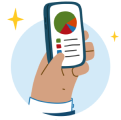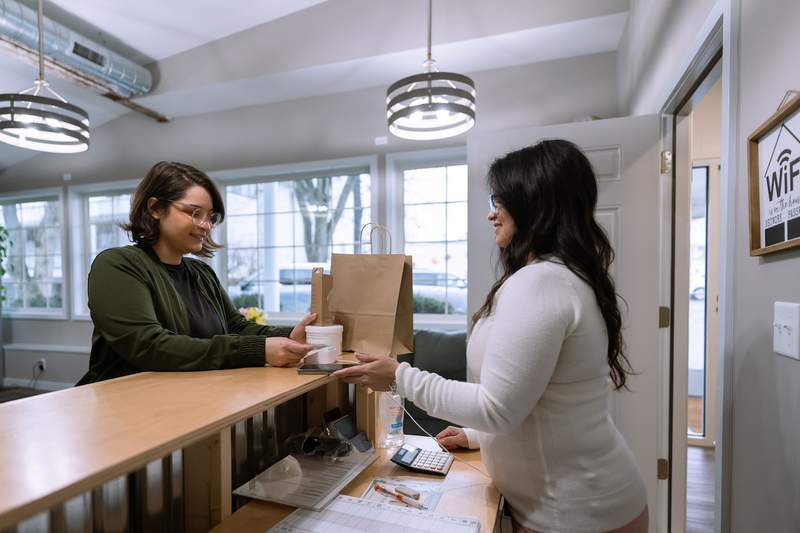A $10,000 loan can help you cover a wide range of expenses, such as emergency home repairs, car maintenance or other essentials. With a low enough rate, a $10,000 personal loan may also be helpful for consolidating debt.
While taking on a personal loan will add to your monthly expenses, getting your hands on a lump sum of cash could help you solve a pressing financial need. Plus, personal loan interest rates are often far lower than those offered by credit cards. Learn more about $10,000 loans, how to apply and when they make sense.
Key Takeaways:
- A $10,000 personal loan can help you cover an emergency, make necessary repairs, pay for essentials or consolidate debt.
- A $10,000 personal loan can have varying interest rates, fees and terms depending on the lender, your credit history and other factors.
- Better credit makes it easier to qualify for a personal loan with a lower interest rate, which can save you thousands over the life of a loan.
Reasons To Get A $10,000 Personal Loan
Getting a $10,000 personal loan is a major financial decision. While there are many reasons to consider a personal loan, we take a closer look at some of the most common reasons below.
- Unforeseen expenses: Life has a habit of throwing unexpected expenses our way. If you need money for an emergency, a personal loan could cover the costs. Some potential emergencies include extensive auto repairs or a sudden job loss that leaves you struggling to cover the basics.
- Debt consolidation: Debt consolidation is a popular reason to take out a personal loan. That’s because you may be able to find a personal loan with a lower interest rate than the credit cards you’re currently paying off. If you can lock in a lower interest rate for your debts, you can save money due to lower interest rates.
For example, say you’re paying off a credit card balance of $10,000 with a 25% interest rate. If you take out a personal loan with an 8% interest rate to pay off your credit card balance, you could save thousands of dollars in interest over a couple of years.
- Home repairs and renovations: If you own a home, you can expect it to need regular home renovations and repairs. If you don’t have enough equity for a home equity loan, a personal loan could help you get the funds you need for necessary repairs.
What’s Your Goal?
Buy A Home
Discover mortgage options that fit your unique financial needs.

Refinance
Refinance your mortgage to have more money for what matters.
Tap Into Equity
Use your home’s equity and unlock cash to achieve your goals.
Reasons Not To Get A $10,000 Personal Loan
While you can technically use a personal loan to cover almost any expense, it’s not the right solution for every financial situation. Below are some situations where opting for a $10,000 personal loan may not be the best financial decision:
- Medical bills: Many medical offices offer financing options for patients who can’t afford to pay the entire bill up front. Make sure to ask about payment plans through the medical office before applying for a personal loan.
- Education expenses: If you or your child is going to college, federal and private student loans are usually an option. Typically, student loans offer lower interest rates than personal loans, and some lenders even prohibit using personal loans for this purpose.
- Other prohibited personal loan uses: Lenders may prohibit certain uses of personal loan funds, which often include business expenses, investment purposes, gambling and house down payments.
Not Sure What Loan Product Is Right For You?
Answer a few sinple questions to compare Refinance, Home Equity and Personal Loan offers.
Where You Can Get A $10,000 Personal Loan
If you’re looking for a $10,000 personal loan, you can find one at a bank, credit union or online lender. While personal loans are widely available, not all lenders are the same: Funding times, interest rates, loan amounts and customer service can all vary from lender to lender.
With that in mind, shop around and compare different types of lenders to find the best fit for your situation. You might focus on finding a lender with low interest rates or one offering a fast funding timeline. While it may benefit you to borrow from a financial institution you already use, you can borrow elsewhere if you find a better deal.
How To Get A $10,000 Loan
If you’ve decided that a $10,000 loan is the right fit for your situation, use the steps below to apply.
1. Check Your Credit Score
Before you start looking at loan options, check your credit history and credit score. In general, a borrower with a higher credit score has a better chance of being approved for a personal loan. With a lower score, you may have trouble qualifying with certain lenders and, when approved, you may face higher interest rates.
If your credit score is relatively low, consider working to improve it before applying for a personal loan. For example, consistently making on-time payments on all your bills could help you improve your score.
2. Collect Your Documentation
Regardless of which lender you work with, you should expect to provide extensive documentation about your financial situation. Prepare by collecting the following paperwork:
- Proof of income: Most lenders expect to see W-2s, 1009s or recent pay stubs.
- Expense information: Your lender may request bank and credit card statements to determine what other financial obligations you have. For example, most lenders will consider how much of your monthly income is already allocated to paying other debts.
- Identification: You’ll need to prove who you are with your Social Security number and a government-issued ID, like a driver’s license or passport.
3. Shop For A Lender
With your documents in hand, shop around for a lender. Consider prequalifying for a loan from multiple lenders to get a rate estimate without a hard credit inquiry.
From there, compare your offers to find the best option for your unique situation. Make sure to look at annual percentage rates (APRs), which tell you how much you can expect to pay in terms of interest and fees on an annual basis. Also, consider repayment timelines to land on the right option that fits your budget.
4. Submit An Application
Once you land on a lender, submit an application. If you apply with multiple lenders, try to complete all of the applications within a 14- – 45-day window to limit the negative impact on your credit score. These days, many lenders accept online applications.
5. Use Your Funds
If you’re approved for a loan, the lender typically sends the funds to your bank account via direct deposit. Funding speed varies based on the lender. When you receive the funds, they’re yours to spend.
6. Repay Your Loan
After issuing the loan, the lender will expect you to start making scheduled repayments. In many cases, you’ll be expected to make monthly payments. Do your best to avoid missing any payments, which can have a serious negative impact on your credit score.
Looking for Access To Money?
Just answer a few simple questions and we’ll help you find the funds you need.
$10,000 Loan: Monthly Payment And Interest Costs
The total cost of a $10,000 personal loan varies widely based on the loan term and attached interest rate. The tables below illustrate how the cost can change based on the interest rate. However, these calculations don’t consider any additional fees or closing costs you might encounter.
3-Year Repayment (36 Months)
| Interest Rate | Monthly Payment | Total Interest |
|---|---|---|
| 10% | $322.67 | $1,616.19 |
| 12% | $332.14 | $1,957.15 |
| 14% | $341.78 | $2,303.95 |
5-Year Repayment (60 Months)
| Interest Rate | Monthly Payment | Total Interest |
|---|---|---|
| 10% | $212.47 | $2,748.23 |
| 12% | $222.44 | $3,346.67 |
| 14% | $232.58 | $3,960.95 |
Can You Get A $10K Loan With Bad Credit?
It may be possible to get a personal loan with bad credit, depending on your lender. However, borrowers with lower credit scores tend to pay higher interest rates. With a higher interest rate, you could end up paying thousands of extra dollars in interest over the course of the loan.
If you have bad credit and can’t qualify for an affordable rate on your own, you might consider adding a co-signer to your application. A co-signer is someone who takes responsibility for the loan if you can’t make payments, and this added security may help improve your chances of qualifying for a loan. Not all lenders allow co-signers, so this is something to consider when comparing loans.
Alternatives To A $10,000 Personal Loan
A personal loan may not be the best option for everyone. If you need to borrow $10,000 but want to avoid a personal loan, consider these alternatives:
- Balance transfer credit card: A balance transfer credit card typically offers 0% interest for an introductory period of around 15 to 18 months. If you can pay off your balance within this window, you can borrow interest free. But beware of your timeline, as rates on these cards can be very high after the intro period.
- Home equity loan: A home equity loan lets you borrow against the equity you’ve built in your house. Like a personal loan, you receive a lump sum up front and make regular monthly repayments. Because it is a secured loan, you might qualify for a lower interest rate compared to an unsecured personal loan. But you could risk foreclosure in the case of default.
- Home equity line of credit (HELOC): A HELOC is similar to a home equity loan, but rather than receiving your loan funds up front, you can borrow from your credit line, which is secured by your home equity. HELOCs have two phases: a draw period, during which you can borrow from your credit line, and repayment period, during which you repay what you borrowed. Unlike personal loans and home equity loans, HELOCs typically have a variable interest rate.
- Personal line of credit: Personal lines of credit are similar to credit cards, but rather than swiping a piece of plastic, you typically access funds with checks or transfers from your checking account. Plus, they may have lower interest rates compared to credit cards.
- Peer-to-peer (P2P) lending: P2P lending allows you to borrow money without going through a traditional lender. P2P lending marketplaces connect borrowers with investors and may not have the same eligibility requirements as banks. Keep in mind that this is a relatively young industry, so you should do your due diligence before borrowing.
$10,000 Personal Loan FAQ
You have questions about taking out a $10,000 personal loan. We have answers.
The Bottom Line About Getting A $10,000 Loan
A $10,000 personal loan can resolve a cash crunch. If you have the cash flow to comfortably repay the loan, then pursuing a $10,000 personal loan could be the right move for your finances. Be sure to compare interest rates, fees and terms to find the best loan for you.

Emily Batdorf
Emily Batdorf is a personal finance writer with five years of experience working with clients like Forbes Advisor, Yahoo! Finance, Credible, Experian and more. With a background in education, Emily loves making complex financial topics accessible to the public. She's written and edited hundreds of articles about budgeting, debt, banking and lending. In addition to writing, Emily is also a co-host of The Finance Girlies podcast, where she celebrates financial conversations among Millennial and Gen Z women.












